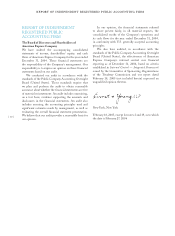American Express 2006 Annual Report Download - page 79
Download and view the complete annual report
Please find page 79 of the 2006 American Express annual report below. You can navigate through the pages in the report by either clicking on the pages listed below, or by using the keyword search tool below to find specific information within the annual report.
[ 77 ]
notes to consolidated fi nancial statements
american express company
Based Compensation” (SFAS No. 123). The Company
recognizes the cost of these awards on a straight-line
basis over their vesting periods.
The following table illustrates the effect on
net income and earnings per common share (EPS)
assuming the Company had followed the fair value
recognition provisions of SFAS No. 123(R) for all
outstanding and unvested stock options and other
stock-based compensation for the two years ended
December 31, 2005. Pro forma disclosures are not
required for periods after the adoption of SFAS No.
123(R):
(Millions, except per share amounts) 2005 2004
Net income as reported $3,734 $3,445
Add: Stock-based employee compensation
expense included in reported net
income, net of related tax effects(a) 208 185
Deduct: Total stock-based employee
compensation expense determined
under fair value based method, net of
related tax effects(b) (217) (369)
Pro forma net income $3,725 $3,261
Basic EPS:
As reported $ 3.03 $ 2.74
Pro forma $ 3.02 $ 2.59
Diluted EPS:
As reported $ 2.97 $ 2.68
Pro forma $ 2.96 $ 2.54
(a) Includes $27 million and $28 million for 2005 and 2004,
respectively, related to Ameriprise.
(b) Includes $(28) million and $(67) million for 2005 and 2004,
respectively, related to Ameriprise.
Marketing, promotion, rewards and
cardmember services
These expenses include the costs of rewards programs
(including Membership Rewards, which is discussed
further in the other liabilities section below), protection
plans and complimentary services provided to
cardmembers, and advertising costs, which are expensed
in the year in which the advertising first takes place.
Cash payments to customers for which the Company
does not receive a specific identifiable benefit (e.g.,
cash-back payments to cardmembers) are classified as a
reduction to revenue.
Interest
This expense includes interest incurred primarily to fund
charge card product receivables and general corporate
purposes.
BALANCE SHEET
Cash and cash equivalents
The Company has defined cash equivalents to include time
deposits and other highly liquid investments with original
maturities of 90 days or less. Restricted cash totaling $425
million and $451 million at December 31, 2006 and 2005,
respectively, is classified in other assets in cases where cash
cannot be utilized for operations.
Accounts receivable
Cardmember receivables
Cardmember receivables represent amounts due from
charge card customers. These receivables are recorded
at the time a cardmember enters into a point-of-sale
transaction with a merchant. Cardmember receivable
balances are presented on the Consolidated Balance
Sheets net of reserves for losses, discussed below, and
includes principal and any related accrued fees.
Reserves for losses — cardmember receivables
Reserves for losses relating to cardmember receivables
represent management’s estimate of the losses inherent
in the Company’s outstanding portfolio of receivables.
Management’s evaluation process requires certain
estimates and judgments. Reserves for these losses
are primarily based upon models that analyze specific
portfolio statistics and reflect, to a lesser extent,
management’s judgment regarding overall reserve
adequacy. The analytic models take into account several
factors, including average write-off rates for various
stages of receivable aging (i.e., current, 30 days, 60 days,
90 days) over a 24-month period and average bankruptcy
and recovery rates. Management considers whether to
adjust the analytic models based on other factors, such
as the level of coverage of past-due accounts, as well as
leading economic and market indicators, such as the
unemployment rate, the consumer confidence index, the
purchasing manager’s index, bankruptcy filings and the
legal and regulatory environment.
Cardmember receivable balances are written off
when management deems amounts to be uncollectible
and is generally determined by the number of days past
due. In general, receivables in bankruptcy or owed by
deceased individuals are written off upon notification,
while other accounts are written off when 360 days past
due. To the extent historical credit experience is not
indicative of future performance, actual loss experience
could differ significantly from management’s judgments
and expectations, resulting in either higher or lower
future provisions for losses, as applicable.
























